Key Takeaways
- Excel date calculations require complex formulas and technical syntax that create barriers for business users tracking deadlines and durations
- Traditional methods like DATEDIF and NETWORKDAYS have limitations and errors that disrupt project timelines and business planning
- Excelmatic's AI delivers instant date calculations with simple language commands, eliminating formula complexity and technical expertise requirements
- Combining Excel knowledge with Excelmatic provides the most efficient approach for accurate date-based analysis in business workflows
In this article, I will walk you through some practical ways to handle dates in Excel. We’ll cover everything from simple subtraction to advanced functions like NETWORKDAYS() and DATEDIF(). By the end, you’ll know how to calculate days between dates, track working days, and even handle specific scenarios like skipping weekends or holidays.
But what if you could do all this without memorizing a single formula? We'll also explore how Excelmatic is revolutionizing data analysis, allowing you to get the same results by simply asking questions in plain language.
Understanding Excel’s Date System
To start, let's talk briefly about Excel's date system. The most important thing to know is that Excel stores each date as a unique serial number. For example, January 1, 1900, is the number 1, and January 2, 1900, is the number 2, and so on. This system is what allows you to perform calculations on dates.
At the risk of making things too complicated, let me also mention two additional things. For one, know that Excel actually uses two systems: the 1900 system and the 1904 system. The 1900 system starts with January 1, 1900, as day 1, and the 1904 system begins with January 1, 1904, as day 0. Also, know that date formats can vary by region. For example, 02/03/2025 could mean February 3 or March 2, depending on where you are. If we’re inconsistent with date formats, Excel may misinterpret the data and produce incorrect results.
These things aren't going to be present problems if you are simply calculating the days between dates, but still, they are good to know.
How to Find Days Between Dates in Excel
There are several methods to find the days between dates in Excel. While traditional formulas are effective, AI-powered solutions offer a much faster and more intuitive alternative. Let's compare.
Method 1: Simple Subtraction
Simple subtraction is one of the easiest and quickest manual ways to find the days between dates. It subtracts the earlier date from the later date. Its syntax is:
New date - Old date
Here, I have a dataset with dates in cells A2 and B2, and in cell C2, I enter the following formula:
=B2-A2
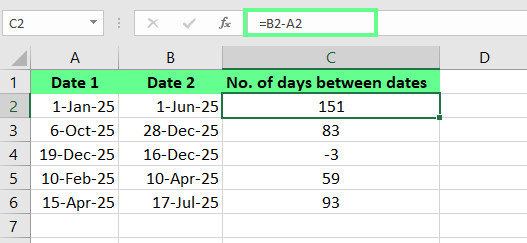 Find days between dates using the subtraction method. Image by Author.
Find days between dates using the subtraction method. Image by Author.
The AI-Powered Way: Using Excelmatic
Instead of typing formulas, you can get the same result with a simple instruction. With Excelmatic, you just upload your file and ask:
Calculate the number of days between the date in column A and the date in column B.
Excelmatic understands your request, performs the calculation for the entire column, and delivers the results instantly. No formulas, no dragging cells.
Method 2: The DAYS() Function
Another way is with the DAYS() function, which is specifically designed for this task. Its syntax is:
=DAYS(end_date, start_date)
In cell C2, I enter the following formula:
=DAYS(B2,A2)
Like subtraction, if the end date is after the start date, the result is positive. If it’s before, it’s negative.
 Find days between dates using the DAYS() function. Image by Author.
Find days between dates using the DAYS() function. Image by Author.
The AI-Powered Way: Using Excelmatic
The prompt for Excelmatic remains just as simple. You can be more specific if you like, referring to the column headers:
Create a new column named 'Duration' that shows the days between 'Start Date' and 'End Date'.
The AI agent handles the function choice and syntax for you.
Method 3: The DATEDIF() Function
Like the DAYS() function, DATEDIF() subtracts dates, but the order of the arguments is reversed. Its syntax is:
=DATEDIF(start_date, end_date, "d")
The third argument, "d", specifies the unit of time (days). This function is more versatile, as you can also use "y" for years or "m" for months.
In cell C2, I entered the following formula:
=DATEDIF(A2, B2, "d")
However, when I pressed Enter, I got a #NUM! error in the third row. That’s because the DATEDIF() function doesn’t allow the end date to be earlier than the start date. It's also a "hidden" function, so Excel won’t autocomplete it for you.
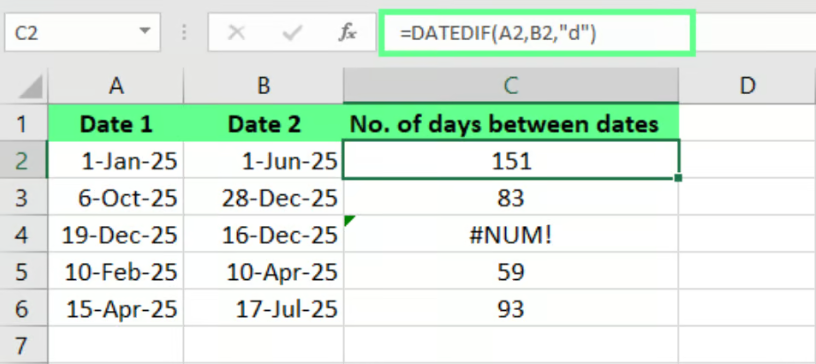 Find the days between the dates using the DATEDIF() function. Image by Author.
Find the days between the dates using the DATEDIF() function. Image by Author.
The AI-Powered Way: Using Excelmatic
This is where Excelmatic truly shines. It eliminates the frustration of hidden functions and strict argument rules. You could ask:
Calculate the difference in days, months, and years between the dates in columns A and B.
Excelmatic would generate all three results without you needing to know the specific codes ("d", "m", "y") or worrying about #NUM! errors.
Method 4: The NETWORKDAYS() and NETWORKDAYS.INTL() Functions
These functions are essential for business contexts, as they calculate working days by excluding weekends and optional holidays. The syntax for NETWORKDAYS() is:
NETWORKDAYS(start_date, end_date, [holidays])
If I want to exclude holidays, I list them in a separate range (e.g., E3:E4) and reference it:
=NETWORKDAYS(A2,B2,$E$3:$E$4)
 Using NETWORKDAYS() function. Image by Author.
Using NETWORKDAYS() function. Image by Author.
For custom weekends (e.g., Friday-Saturday), NETWORKDAYS.INTL() is used, which adds another layer of complexity to the formula.
The AI-Powered Way: Using Excelmatic
Manually setting up holiday ranges and choosing the right NETWORKDAYS function can be tedious. With Excelmatic, you just state the conditions:
How many working days are between the start date and end date? Exclude weekends and the holidays listed in the 'Holidays' column.
It's that simple. The AI handles the complex logic of identifying weekends and referencing your holiday list.
Method 5: The TODAY() Function
The TODAY() function returns the current date, making it perfect for dynamic calculations like days passed or days remaining.
=TODAY() - past_date
Let’s say the past date is in cell A3. The formula in cell B3 would be:
=TODAY()-A3
 Find the days left since the date with the TODAY() function. Image by Author.
Find the days left since the date with the TODAY() function. Image by Author.
The AI-Powered Way: Using Excelmatic
Again, you can describe the outcome you want, and Excelmatic will incorporate the TODAY() function automatically.
For each date in column A, calculate how many days have passed until today.
This is far more intuitive than remembering to subtract the past date from the TODAY() function.
A Quick Comparison of All Methods
| Method | What I like | What I don’t like |
|---|---|---|
| Excelmatic | Uses plain language, no formulas to remember. Handles simple and complex scenarios (like holidays) with ease. Extremely fast for business users. | Requires file upload. Works as an AI assistant rather than an in-cell function. |
| Simple subtraction | Quick and easy | It doesn’t account for weekends or holidays |
| DAYS() | Clear and structured syntax | It only works for days |
| DATEDIF() | Flexible for days, months, or years | Throws an error when the value is negative |
| NETWORKDAYS() / .INTL() | Excludes weekends and holidays | Requires extra setup for holidays and complex syntax |
| TODAY() | Updates automatically every day | It only works for calculations involving the current day |
Advanced Techniques
While manual methods require learning advanced techniques to handle edge cases, Excelmatic often manages this complexity for you automatically.
Handling Negative Values & Errors
Traditionally, to fix negative results from reversed dates, you'd wrap your formula in the ABS() function: =ABS(DAYS(B2,A2)). To manage potential errors like #VALUE! or #NUM!, you'd use IFERROR(). These are powerful skills but add another layer of formulas to learn.
With Excelmatic, these issues are often bypassed. The AI is designed to interpret your data correctly, and you can simply ask for the "absolute difference" or tell it how to handle errors in your natural language prompt, without touching a single formula.
Combining Functions
A common advanced task is combining functions. For example, to find the remaining school days until an exam, you might use:
=IFERROR(NETWORKDAYS(TODAY(), A2, $B$3:$B$4), "Check Dates")
This formula is powerful but difficult to write and debug for a beginner.
With Excelmatic, the request is straightforward:
How many school days are left until the exam date in column A, excluding the holidays in column B? If there's an error, say 'Check Dates'.
The AI builds the complex formula behind the scenes, giving you the result you asked for.
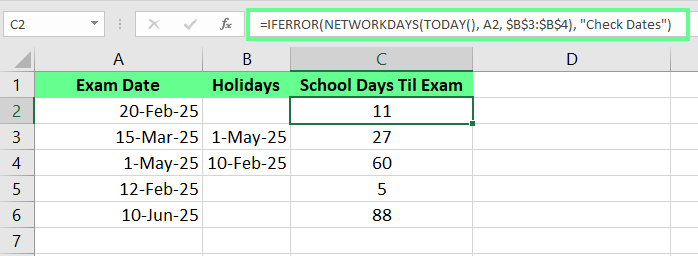 Complex formulas can be replaced by simple AI prompts. Image by Author.
Complex formulas can be replaced by simple AI prompts. Image by Author.
Real-World Examples: The Traditional vs. The AI Way
Let's see how these approaches compare in real-life scenarios.
Calculating Age
Traditional Way: Use DATEDIF() to find the number of full years between a birth date and today.
=DATEDIF(A2,TODAY(),"Y")
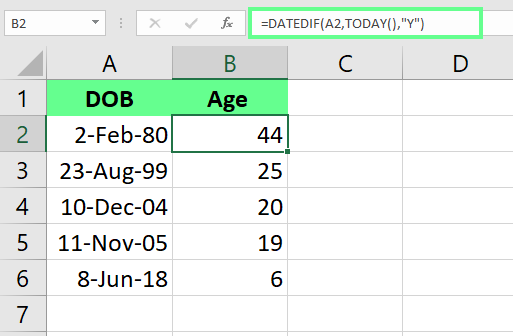 Find the age using the DATEDIF() function. Image by Author.
Find the age using the DATEDIF() function. Image by Author.
Excelmatic Way:
Calculate the current age in years for each person using the 'Date of Birth' column.
Project Timeline Tracking
Traditional Way: Use NETWORKDAYS() with a holiday range to track remaining workdays.
=NETWORKDAYS(A2,B2,$C$3:$C$5)
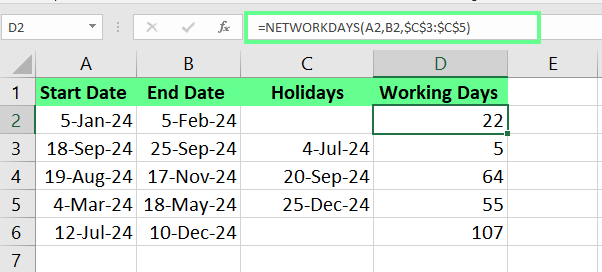 Find the days left for the project using NETWORKDAYS() functions. Image by Author.
Find the days left for the project using NETWORKDAYS() functions. Image by Author.
Excelmatic Way:
For each project, calculate the total working days between the 'Start Date' and 'End Date', excluding the list of holidays provided.
Financial Analysis (Contract Deadlines)
Traditional Way: Use an IF statement to check if a contract is expired.
=IF(B2 < TODAY(), "Expired", "Active")
You would then set up conditional formatting rules based on this text.
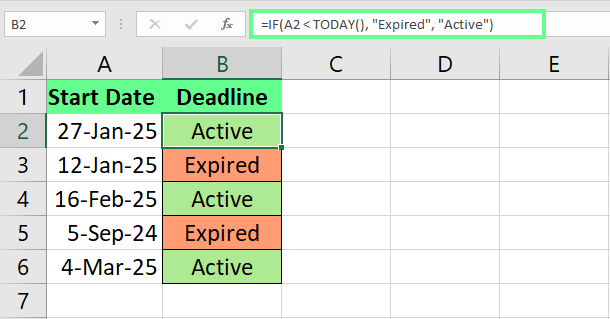 Track the contract deadline. Image by Author.
Track the contract deadline. Image by Author.
Excelmatic Way:
Create a 'Status' column. If the 'Expiration Date' is before today, label it 'Expired', otherwise 'Active'. Then, highlight rows with 'Expired' status in red.
Excelmatic can handle both the calculation and the formatting in one step.
Tips and Best Practices
- Correct Formatting is Key: Always ensure your date cells are formatted as 'Date'. This is crucial for both manual formulas and for AI tools to interpret your data correctly.
- Use Cell References: Instead of hardcoding dates in formulas, use cell references (e.g.,
A2,B2). This makes your sheet dynamic. - Keep It Simple: With manual formulas, clarity is important. With AI tools, keep your prompts clear and direct. Describe the end result you want.
- Embrace AI for Efficiency: For repetitive or complex date calculations, consider using Excelmatic. It saves time, reduces errors, and lets you focus on analyzing the results rather than building the formulas.
Final Thoughts
I’ve shared some of the best ways to work with dates in Excel, from traditional formulas like DAYS() and NETWORKDAYS() to the modern, AI-powered approach. While learning Excel functions is a valuable skill, Excelmatic* is changing the game for business professionals by making date calculations more accessible and efficient than ever before.
Whether you're tracking project deadlines, calculating business days, or managing contract expirations, Excelmatic eliminates the technical complexity and delivers instant, accurate results with simple language commands.
Ready to simplify your date calculations in Excel? Start using Excelmatic today and experience instant, AI-powered date analysis.
FAQ
How do I calculate the difference between two times in hours, minutes, and seconds while ignoring the other units?
You can use these formulas:
- Hours:
=HOUR(B2-A2) - Minutes:
=MINUTE(B2-A2) - Seconds:
=SECOND(B2-A2)
Note: The result will not exceed 24 hours or 60 minutes/seconds.
How do I calculate the number of hours between two times in Excel?
To calculate hours as a decimal, use=(B2-A2)*24, and to get complete hours, use =INT((B2-A2)*24).
What are the keyboard shortcuts to quickly insert the current date or time in Excel?
Here’s how you can do this:
- Press Ctrl + ; to insert the current date.
- Press Ctrl + Shift + ; to insert the current time.
How do I calculate the number of weeks between two dates?
To calculate the number of weeks between two dates, divide the number of days by 7. You can use the following formula: = (End_Date - Start_Date) / 7.






